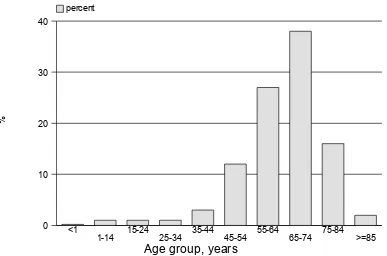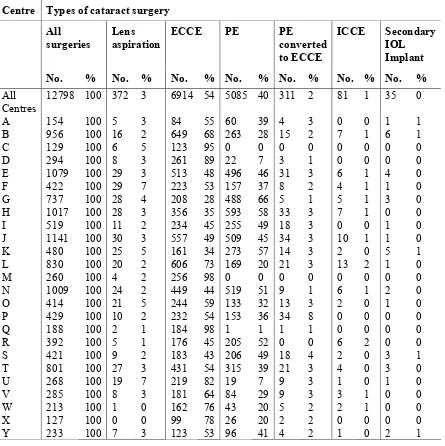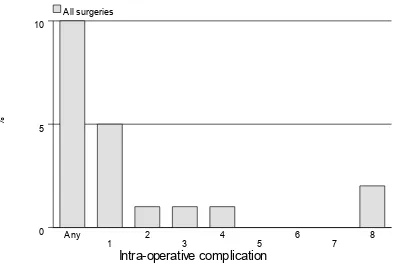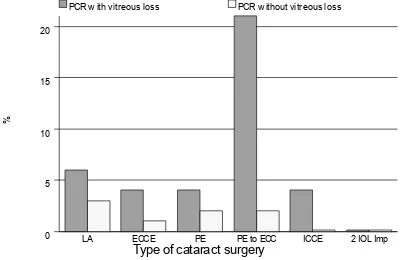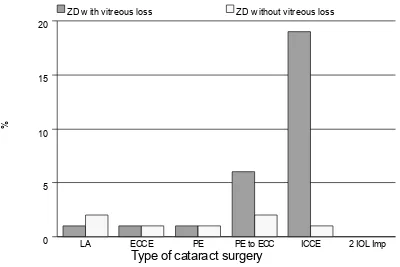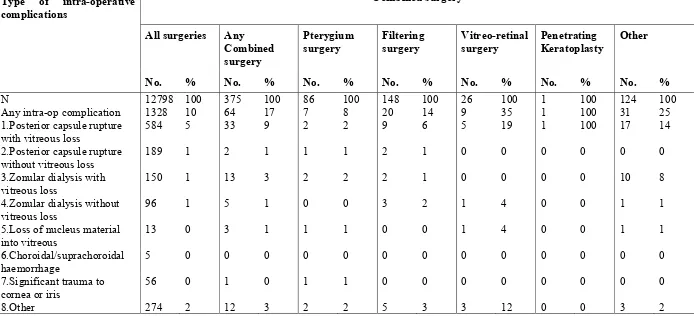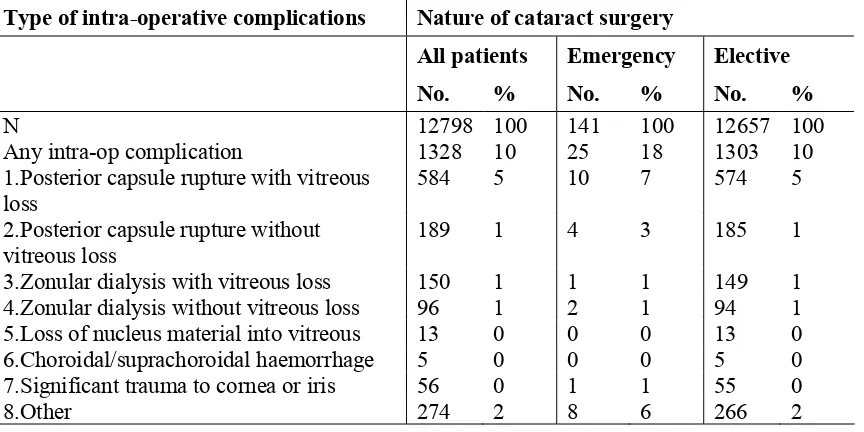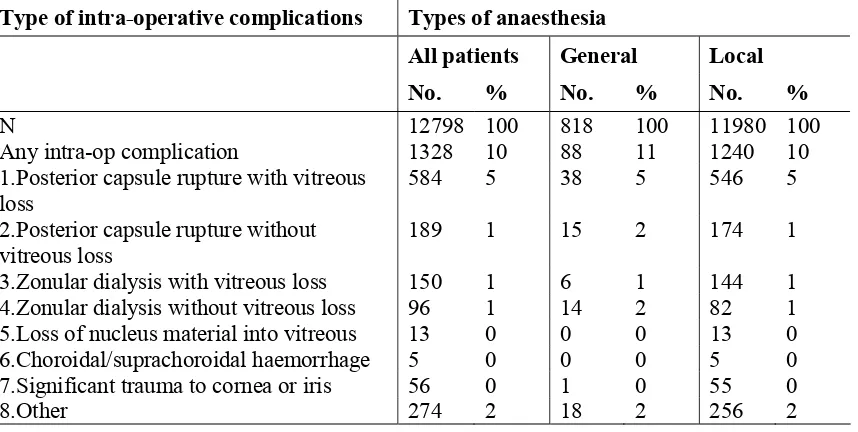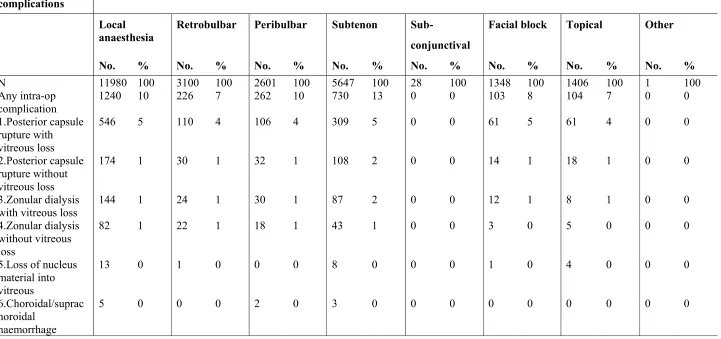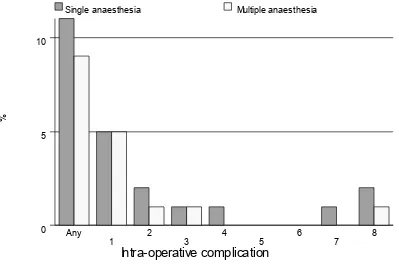National Cataract Surgery Registry
Ministry of Health Malaysia
THE FIRST REPORT OF THE
NATIONAL CATARACT SURGERY REGISTRY
2002
Edited by
Goh Pik Pin Shamala Retnasabapathy
Rajalakshmi Gopal Ronald Arun Das
A publication of the
National Cataract Surgery Registry And
Clinical Research Centre, Ministry of Health
Published by the
National Cataract Surgery Registry (NCSR) C/O Disease and Treatment Registry Unit 2nd Floor, Wisma MEPRO
29 & 31 Jalan Ipoh 51200 Kuala Lumpur Malaysia
Direct Line: 603-4045 5652
General Line: 603-4045 5408 Ext: 15/25 Fax: 603-4045 1252
Email ncsr@crc.gov.my
Website: http://www.crc.gov.my/ncsr
Disclaimer
The data reported here have been supplied by NCSR. The interpretation and reporting of these data are the responsibility of the Editor and in no way should be seen as an official policy or interpretation of the NCSR.
Suggested citation
The suggested citation for this report is as follows:
Goh Pik Pin, Shamala Retnasabapathy, Rajalakshmi Gopal, Ronald Arun Das.(Eds) THE FIRST REPORT OF THE NATIONAL CATARACT SURGERY 2002 Kuala Lumpur, Malaysia 2003
Electronic version
i FOREWARD
Congratulations to all concerned on the successful completion of the first annual report of the National Cataract Surgery Registry (NCSR).
Cataract surgery is the most common surgery performed in Ophthalmology Departments in the Ministry of Health Hospitals. Outcome of cataract surgery services therefore serves as an indicator of the quality of Ophthalmic surgical services. It is in this light that the National Cataract Surgery Registry (NCSR) was established and data collection started on the first of January 2002. A preliminary report on twenty-two participating centres for the period January to March 2002 has been published.
NCSR has since served as a tool to collect and analyze data for the evaluation of cataract surgery services in MOH hospitals. Useful information had been gathered on the pattern of cataract surgery, its surgical and service outcome over the past one year. Data can be retrieved for surgical audit by individual centres.
This report also provides an insight into the training needs for cataract surgery. I am positive that this information can be used to improve cataract surgery services at the local and national level.
On behalf of the NCSR Advisory Committee, I would like to thank all source data producers, individuals and institutions that have made it possible for the completion of this annual report. Your continued participation and contribution is of utmost importance in ensuring the sustainability of the registry.
Dr. Mariam Ismail Chairman
ACKNOWLEDGMENTS
When we read a report, we often do not recognize the hard work and effort many people have put in to make the report a reality. The birth of the first National Cataract Surgery Registry (NCSR) annual report owed its success to many people.
Without the perseverance of staff at the participating canters in data collection, particularly the doctors who filled in the clinical record forms and the paramedical staff who collected and sent the forms to cataract surgery registry unit (CSRU), we would not have the data.
Without the painstaking follow-up in case ascertainment and tedious checking of completeness of data by the staff at CSRU, particularly the Clinical Registry Manager Staff Nurse Lee Poe Poay and Disease & Treatment Registry Associate, Ms Sharmila Bt Saari, we will not have good quality data.
Without the careful analysis of the data by Dr. LimTeck Onn and Ms Teh Poh Geok , we would not have the data made into meaningful tables and figures.
Without the conversion from figures and tables into wordsby the editors consisting of Dr. Goh Pik Pin, Dr. Shamala Retnasabapathy, Dr. Rajalakshmi Gopal, and Dr. Ronald Arun Das, we will not have the report.
Without the support of the Development Division of the Ministry of Health, Ophthalmology Service and Clinical Research Centre , NCSR would not be born.
We are also very grateful to:
The Ministry of Health, in particular, the Deputy Director General (Research and Technical Support) Dato` Dr. Mohd Ismail Merican, whose support was absolutely crucial to getting the NCSR started by providing the seed money in the form of a research grant (Grant number: MRG-2002-2).
The Director, Kuala Lumpur Hospital, Dr. Haji Ramlee B Haji Rahmat for contributing in the resources required.
The financial sponsors: Alcon Laboratories (M) Sdn Bhd, Advanced Medical Optics and Pharmacia Ophthalmology Malaysia Sdn Bhd ( currently as Pfizer ( Malaysia) Sdn Bhd).
The National Cataract Surgery Registry Advisory Committee would like to thank all the above. As the registry is an on going undertaking, your continuous supports are very much appreciated and hope for.
Thank you very much.
iii
PARTICIPATING CENTRES
1. 94 Hospital Angkatan Tentera KemTerendak
Head, Ophthalmology Department: Lt Kol (Dr) Nor Aishah Bt Malik Site Coordinator: PW II Foziah Bt Yusof
2. Alor Setar Hospital
Head, Ophthalmology Department: Dr. Ahmad Mat Saad
Site Coordinator: Dr. Zaharidah Bt. Abd. Kadir T/AN Siti Aishah Salim 3. Batu Pahat Hospital
Head, Ophthalmology Department: Dr. Chandra Mohan Site Coordinator: MA Hasim Buniran
4. Bukit Mertajam Hospital
Head, Ophthalmology Department: Dr. Teoh Hian Jin Site Coordinator: S/N Masheran Bt. Musa
5. Duchess of Kent Sandakan Hospital
12.KualaTerengganu Hospital
Head, Ophthalmology Department: Dr. Zuraidah Mustari Site Coordinator: S/N Juriffah Mohd Amin
13.Umum Sarawak Kuching Hospital
Head, Ophthalmology Department: Dr. Intan Gudom
Site Coordinator: S/N Hjh Fatimah Hassan
14.Melaka Hospital
Head, Ophthalmology Department: Dr. S. Anusiah Site Coordinator: Dr. Meena Kandiah
S/N Soon Bee Wan 15.Miri Hospital
Head, Ophthalmology Department: Dr. Daw Saw Thein Site Coordinator: MA Musa Zaini
16.Muar Hospital
Head, Ophthalmology Department: Dr. Adnan Abas Site Coordinator: MA Nuruhadi
17.Mentakab Hospital
Head, Ophthalmology Department: Dr. Azhar Zainuddin
Site Coordinator: MA Hj. Abdul Akim B. Sabit Ali
18.Putrajaya Hospital
Head, Ophthalmology Department: Dr. Salmah Othman Site Coordinator: S/N Sarniah Sidek
19.Pulau Pinang Hospital
Head, Ophthalmology Department: Dr. Elizabeth John Site Coordinator: En. Azahari B. Ahmad
MA Samsuddin Shahul Hamid
20.Queen Elizabeth Kota Kinabalu Hospital
Head, Ophthalmology Department: Dr. Dayang Sayalam Ag Daud Site Coordinator: S/N Eugenie
21.Seremban Hospital
Head, Ophthalmology Department: Dr. Bethel Livingstone Site Coordinator: MA Thivagaran
22.Sibu Hospital
Head, Ophthalmology Department: Dr. Reddy
v
23.Sultanah Aminah Johor Baharu Hospital
Head, Ophthalmology Department: Dr. Loh Swee Seng Site Coordinator: Dr. Suresh
S/N Hapsah Bt Ali 24.Sungei Petani Hospital
Head, Ophthalmology Department: Dr. Foo Sui Wan Site Coordinator: S/N Zainab
25.Taiping Hospital
Head, Ophthalmology Department: Dr. Wong Sook Mun
Site Coordinator: S/N Norashah Bt Abd. Hamid
26.Tawau Hospital
Head, Ophthalmology Department: Dr. Ajit Majumder Site Coordinator: MA Bacho Bin Nordin
27.Teluk Intan Hospital
Head, Ophthalmology Department: Dr. Vivian Gong Hee Meng Site Coordinator: MA Halim
28.Tengku Ampuan Afzan Kuantan Hospital
Head, Ophthalmology Department: Dr. Vasantha Kumar Site Coordinator: MA Nadarajah
S/N Rosila
29.Tengku Ampuan Rahimah Klang Hospital
Head, Ophthalmology Department: Dr. Yogan Kanagasabai Site Coordinator: Dr. Norlelawati
S/N Wong Huey Fen
30.Universiti Sains Malaysia Hospital
NATIONAL CATARACT SURGERY REGISTRY ADVISORY COMMITTEE
Dr. Mariam Ismail Chairperson
Head, Ophthalmology Service, MOH and
Head, Ophthalmology Department, Selayang Hospital
Dr. Goh Pik Pin Co-Chairperson
Ophthalmologist,
Ophthalmology Department, Hospital Selayang
Datuk Dr. Abdul Gani B. Mohammed Din
Director,
Medical Development Division Ministry of Health
Dr. Gomathy Arumugam President,
Ophthalmology Society Malaysian Medical Association
Dato' Dr. P. Balaravi Head,
Ophthalmology Department, Ipoh Hospital
Dr. Bethel Livingstone Head,
Ophthalmology Department, Seremban Hospital
Dr. Joseph Alagaratnam Head,
Ophthalmology Department, Kuala Lumpur Hospital
Dr. Zuraidah Bt. Mustari Head,
Ophthalmology Department, Kuala Terengganu Hospital
Dr. Hamidah Bt. Budin Ophthalmologist,
Ophthalmology Department, Hospital Kota Bharu
Associate Prof. Dr. Muhaya Bt. Mohamad
Head,
Ophthalmology Department, Universiti Kebangsaan Malaysia
Dr. Elias Hussein Head,
Ophthalmology Department, Universiti Sains Malaysia
Dr. Hoh Hong Beng Private,
Pantai Medical Centre, Kuala Lumpur
Dato Dr. Y. C. Lee Private,
Lee Eye Centre, Ipoh, Perak
Dr. Lim Teck Onn Head,
Clinical Research Centre, Kuala Lumpur Hospital
Dr. Rugayah Bakri Head,
Evidence Based Medicine
Clinical Research Centre, Kuala Lumpur Hospital
vii
ABOUT NATIONAL CATARACT SURGERY REGISTRY
INTRODUCTION
The National Cataract Surgery Registry is a disease outcome registry. It is a prospective, ongoing systematic collection of data pertaining to patients who have had cataract surgery. Data collected include demography, operative events, post-operative visual outcomes and probable causes for poor outcome. These data are used to calculate cataract surgery rates and to evaluate surgical outcome. Such information is useful for performance audit in each participating ophthalmology department, leading to improvement in cataract surgery service, and to assist Ministry of Health, non-governmental organization, private eye care providers and industry in blindness prevention programme planning and evaluation in the country. Analyzed data is presented in report and is disseminated to contributors and other users of the registry at a timely and regular fashion.
NCSR was established in January 2002. Till date, there are 30 source data producers/participating centres in the registry consisting of 28 ophthalmology departments from the Ministry of Health Hospitals, Hospital Angkatan Tentera Kem Terendak, and Universiti Sains Malaysia Hospital.
OBJECTIVES
The objectives of National Cataract Surgery Register are to:
1. Determine the frequency and distribution of cataract surgery in Malaysia. These are useful measures of the health burden arising of cataract and its treatment provision in the country
2. Determine the outcomes, and factors influencing outcomes of cataract surgery. This serves the needs of outcome assessment.
3. Evaluate cataract surgery services. This serves the need of accountability. 4. Stimulate and facilitate research on cataract and its management.
The objectives listed above, while typical of any cataract surgery registry, is clearly rather ambitious and certainly cannot be met right away. Thus the registry is implemented in phases.
Phase 1 of the proposed cataract surgery register shall be limited to Public Hospitals only.
Phase 2 of the proposed cataract surgery register shall expand the coverage of Phase 1 to include university, private hospitals and private ophthalmologists in the country.
SPONSORS OF NCSR
CLINICAL RESEARCH CENTRE
The Clinical Research Centre is the designated collaborating unit to the NCSR. It provides the functional capacity to support the operations of the NCSR.
The CRC is the clinical research arm of the Ministry of Health. Apart from the NCSR, CRC currently also supports the National Renal Registry, National Cancer Registry, National Neonatal Registry, National Mental Health Registry and National HIV/AIDS Treatment Registry.
In recent years, CRC has emerged to become the preferred collaborating partner for medical professional groups to establish disease and treatment registries in the country. This is because CRC possesses sophisticated facility and equipment, state of the art technology, and most importantly the trained human resources such as registry managers, epidemiologists, statisticians, information technology professionals and other supporting staff skilled in registry operations. These resources are consolidated in the Disease and Treatment Registry Unit in the CRC. The unit specializes in assisting medical professionals to establish and operate their registries.
Staff of the Clinical Research Centre (CRC) and Cataract Surgery Registry Unit (CSRU) of Disease & Treatment Registry Unit (DTRU)
Director Dr. Zaki Morad B Mohamad Zaher
Head Dr. Lim Teck Onn
Head of DTRU Dr. Rugayah Bakri Cataract Surgery Registry Manager
CSRU
SN Lee Poe Poay
Clinical Registry Associate CSRU Ms. Sharmila Bt Saari
Clinical Registry Associate CSRU Mr. Mohamad Fauzan B Jamaluddin Information Security Officer Ms Celine Tsai Pao Chien
Network Administrator Mr. Kevin Ng Hong Heng Assistant Network Administrator Mr. Adlan Ab. Rahman Database Administrator Ms. Lim Jie Ying
1 CONTENTS
FOREWARD...i
ACKNOWLEDGMENTS ...ii
PARTICIPATING CENTRES ...iii
NATIONAL CATARACT SURGERY REGISTRY ADVISORY COMMITTEE ...vi
ABOUT NATIONAL CATARACT SURGERY REGISTRY...vii
CLINICAL RESEARCH CENTRE...viii
CONTENTS...1
ABBREVIATIONS ...5
GLOSSARY...5
REGISTRY METHODS ...6
1.ORGANISATION AND ADMINISTRATIVE STRUCTURE ...6
2.DATA STANDARDS...8
3.DATA FLOW PROCESS...8
OVERALL DATA MANAGEMENT FLOW ...10
OVERALL DATA FLOW PROCESS...11
4.LEGAL ASPECT AND CONFIDENTIALITY ...12
REPORT SUMMARY...13
1 PATIENTS’ CHARACTERISTICS ...13
2 CATARACT SURGERY PRACTICE ...14
3 CATARACT SURGERY OUTCOMES ...15
3.1 CATARACT SURGERY COMPLICATIONS INTRA-OPERATIVE....15
3.2 CATARACT SURGERY COMPLICATIONS POST-OPERATIVE ...16
3.3 ANALYSIS ON CATARACT SURGERY OUTCOMES...17
3.4 POST-OPERATIVE VISUAL ACUITY ...17
3.5 POST-OPERATIVE REFRACTED VA IMPROVED BY ONE OR MORE LINE SNALLEN CHART ...20
3.6 FACTORS CONTRIBUTING TO POST-OPERATIVE VA WORSE....20
THAN 6/12...20
LIST OF TABLES
Table 2.6 : Distribution of single and multiple local anaesthesia ...39
Table 2.7 : Type of sedation given to patient who had local anaesthesia...40
Table 2.8 : Distribution of IOL placement...41
Table 2.9 : Distribution of cataract surgery without IOL ...42
Table 2.10 : Distribution of IOL- materials and types...43
Table 3.1.1 : Distribution of intra-operative complications by type of cataract surgery...44
Table 3.1.2 : Distribution of intra-operative complications by combined surgery ...48
Table 3.1.3 : Distribution of intra-operative complications by nature of cataract surgery...49
Table 3.1.4 : Distribution of intra-operative complications by type of anaesthesia .50 Table 3.1.5 : Distribution of intra-operative complications by type of local anaesthesia ...51
Table 3.1.6 : Distribution of intra-operative complications by single or multiple local anaesthesia...53
Table 3.1.7 : Distribution of intra-operative complications by type of sedation ...54
Table 3.1.8 : Distribution of intra-operative complications by sedation ...56
Table 3.1.9 : Distribution of intra-operative complications by cataract surgery with IOL...57
Table 3.1.10 : Distribution of intra-operative complications by cataract surgery without IOL...59
Table 3.2.1 : Distribution of post-operative complications ...61
Table 3.2.2 : Distribution of post-operative complications by IOL types ...62
Table 3.2.3 : Distribution of post-operative complication by material...63
Table 3.2.4 : Post-operative complication by centre...64
Table 3.3.1 : Median follow-up period in weeks (Patients with only unaided vision, refraction was not performed)...68
Table 3.3.2 : Median follow-up period in weeks (Patients with refracted vision)....68
Table 3.4.1 : Distribution of post-operative VA ...69
Table 3.4.2 : Distribution of post-operative refracted VA 6/12 or better at the last follow up, by surgery ...71
Table 3.4.3 : Distribution of post-operative refracted VA 6/12 or better in relation to age and type of surgery ...72
Table 3.4.4 : Distribution of post-operative refracted VA 6/12 or better in relation to gender and type of surgery...73
3
Table 3.4.6 : Distribution of post-operative refracted VA 6/12 or better in relation to complication and type of surgery...75 Table 3.4.7 : Distribution of post-operative refracted VA 6/12 or better in relation to nature of surgery and type of surgery ...76 Table 3.4.8 : Distribution of post-operative refracted VA 6/12 or better in relation to anaesthesia and type of surgery ...77 Table 3.4.9 : Distribution of post-operative refracted VA 6/12 or better in relation to combined surgery and type of surgery...78 Table 3.4.10 : Distribution of post-operative refracted VA 6/12 or better in relation to IOL and type of surgery...79 Table 3.4.11 : Distribution of post-operative refracted VA 6/12 or better in relation to surgeon status and type of surgery without ocular co-morbidity...80 Table 3.4.12 : Distribution of post-operative refracted VA 6/12 or better in relation to centre and type of surgery...81 Table 3.5.1 : Distribution of post-operative refracted VA improved by one or more line of Snellen chart, at the last follow up ...83 Table 3.5.2 : Distribution of post- operative refracted VA improved by one or more line of Snellen chart, with and without ocular co-morbidity at the last follow up ...84
Table 3.5.3 : Distribution of post- operative refracted VA improved by one or more line of Snellen chart with intra-op complication and without intra-op
LIST Of FIGURES
Figure 1.1 : Age Distributions ...21
Figure 1.3 : Number (%) of surgery...22
Figure 1.4 : Number of surgery done by centre ...24
Figure 1.5 : Distribution of day care and in patient by centre ...26
Figure 1.9 : Pre-operative visual acuity measurement...29
Figure 2.1 : Distribution of types of cataract surgery by centre ...32
Figure 2.4 : Type of anaesthesia ...36
Figure 3.1.1.1 : Distribution of intra-operative complication ...45
Figure 3.1.1.2 : Distribution of intra-operative complication by posterior capsule rupture with vitreous loss and posterior capsule rupture without vitreous loss ...46
Figure 3.1.1.3 : Distribution of intra-operative complication by zonular dialysis with vitreous loss and zonular dialysis without vitreous loss ...47
Figure 3.1.3 : Distribution of intra-operative complications by nature of cataract surgery...49
Figure 3.1.4 : Distribution of intra-operative complications by type of anaesthesia 50 Figure 3.1.6 : Distribution of intra-operative complications by single or multiple local anaesthesia...53
Figure 3.1.7 : Distribution of intra-operative complications by type of sedation...55
Figure 3.1.8 : Distribution of intra-operative complications by sedation ...56
Figure 3.1.9 : Distribution of intra-operative complications by cataract surgery with IOL...58
Figure 3.1.10 : Distribution of intra-operative complications by cataract surgery without IOL...60
Figure 3.4.1.1 : Distribution of post-operative VA...69
Figure 3.4.1.2 : Cumulative distribution of visual acuity by pre- and post-operative unaided VA ...70
Figure 3.4.1.3 : Cumulative distribution of visual acuity by pre- and post-operative refracted VA...70
5 ABBREVIATIONS
CF Counting finger CI Confidence interval CMO Cystoid macular oedema CSRU Cataract surgery registry unit ECCE Extraca psular cataract extraction HM Hand movement
IOL Intraocular lens
ICCE Intracapsular cataract extraction NPL No perception of light
PCO Posterior capsule opacification PCR Posterior capsule rapture PE Phacoemulsification PL Perception of light
SDP Source data producers VA Visual acuity
ZD Zonular dialysis
GLOSSARY
Advisory Committee
A committee, board, council, panel or group thereof that is established by the sponsors of the registry to govern the registry. The Advisory Committee shall direct and control the activities of the designated collaborating unit, which manages the day-to-day operations of the registry.
Advisory Committee member
An individual appointed to serve on an advisory committee. Members may have relevant expertise and/or represent the interest of SDP, users or donor.
Chairperson An advisory committee member who is appointed to preside at committee meetings and ensure that all rules of order and conduct are maintained during each session.
Disease Register The ongoing systematic collection, analysis and interpretation of a specific disease data essential to the planning, implementation and evaluation of clinical and public health practice, closely integrated with dissemination of these data to those who need to know. The final link in the chain is the application of these data to the management, prevention and control of the disease. A registration system includes a functional capacity for data collection, analysis and dissemination linked to clinical and public health programs.
Secretary The individual responsible for an advisory committee’s overall
administrative management. He/she is ordinarily a staff provided by the designated collaborating unit for the purpose.
Source data producer
The individuals or institutions that report the required data to the registry.
REGISTRY METHODS
The following aspects of registry methods are described below. 1. Organization and Administrative structure
2. Data standards 3. Data flow process
4. Legal aspects and confidentiality
1.ORGANISATION AND ADMINISTRATIVE STRUCTURE
In brief, the organizational structure of NCSR consists of sponsors, advisory committee, cataract surgery registry unit (CSRU), source data producers and target groups/users. The Ophthalmology Service and the Clinical Research Centre, both of the MOH, jointly sponsor the registry. The NCSR is governed by an advisory committee who oversees the operations of registry. The cataract surgery registry unit, which is based at the Clinical Research Centre, MOH, provides the functional capacity to support the operation of NCSR. The source data producers are Departments of Ophthalmology, both public and private, who provide data on patients who have had cataract surgeries. The users or target groups are individuals or institutions to which the regular registry reports are addressed.
The description of the duties and functions of each entity depicted follows.
Sponsor
The registry is jointly sponsored by the Ophthalmology Service and the Clinical Research Centre; both of the MOH.
Sponsors shall
♦ Be responsible to Director General of Health, MOH for the effective, efficient and responsive operations of the registry.
♦ Provide leadership and direction for the registry.
♦ Establish an Advisory Committee, jointly chair the committee and appoint members to the Advisory committee. Membership should represent all interested parties. These must include source data producers, Target groups or users and representative from the Cataract Surgery Registry Unit.
♦ Provide the financial, human and information resources required, if necessary with financial contribution from industry or donor agencies.
Sponsor
Advisory Committee
Source Data Producers
Cataract Surgery Registry Unit
7 Advisory Committee
An Advisory Committee for cataract surgery register shall be established by sponsors to oversee the operations of registry. Interested parties including source data producers and target groups or users are represented on this committee.
The Committee shall
♦ Provide leadership and direction for cataract surgery registry. ♦ Ensure the continuing relevance of registry.
♦ Determine policy and procedures for the operations of the registry. ♦ Designate a collaborating unit to be the Cataract Surgery Registry Unit. ♦ Oversee the progress of registry.
♦ Facilitate access to data sources.
♦ Galvanize commitment of all stakeholders.
Cataract Surgery Registry Unit (CSRU)
The CSRU in the Clinical Research Centre (CRC) is established to provide functional capacity to support the operation of the NCSR. Here, the collection and analysis of data, and feedback of information collected are performed. CSRU is a sophisticated unit staffed by epidemiologist, statistician, information technology personnel and other supporting staff.
To achieve the objectives of the NCSR, the function of CSRU is to ensure: 1. The complete enumeration of all cataract surgery done at the SDP centres 2. The validity of the data collected
Source Data Producers (SDP)
These are individual Departments of Ophthalmology who collects the required data. It is the most costly and difficult element of the system. As the data collected has to be systematic and uniform, and producers of source data need to be trained and motivated to ensure high data quality.
There are 29 Ophthalmology departments under Ministry of Health (MOH), one under Ministry of Defense and 3 in the local universities. Of these public operated ophthalmology departments, 30 registered as source data producers in the year 2002. This gives a coverage rate of 86% in the government hospitals. If only the MOH hospitals are taken into account, the coverage rate is 100%. Of the 30 SDPs, 22 participated for the full year. The registry aims to invite other university hospitals, private institutions and private ophthalmologists to participate in the registry in the coming year.
Users or Target groups
These are the individuals or institutions to which the regular registry reports are addressed.
They include
• Public health practitioner • Health provider
• Researcher • Press and public
It is their needs for information to assist in planning and implementing disease management, control and prevention activity that justify the investment in registry.
2.DATA STANDARDS
The data collected are patient demography, cause of cataract, first or second eye surgery, prior intra-ocular surgery, pre-existing ocular morbidity and systemic co-morbidity, pre-operative unaided and refracted vision, surgeon’s status, type of admission (day care or non day care surgery), urgency of surgery, type of anesthesia, types of sedation, types of IOL (placement of IOL, material, foldable or non-foldable), and intra-ocular complication, post-operative complications, post-operative best corrected visual acuity by 12 weeks, and possible factors contributing to post-operative refracted VA of worse than 6/12.
3.DATA FLOW PROCESS
Inclusion criteria
All patients, regardless of age, who have undergone cataract surgery, including those who have combined cataract surgery, are included in the registry. Patients who have their lens removal, decided by surgeons while performing the other surgeries, usually during vitreo-retinal surgery were excluded.
Data Collection On Clinical Record Forms
Three clinical record forms are used in NCSR. They are: i. Pre-clerking record
ii. Operative records
iii. Cataract surgery outcomes through 12 weeks post-op record
These forms are used as medical records in the day-to-day patient care at the eye departments, with duplicate copies to be sent to CSRU. By doing so, there is no additional work in data collection.
The pre-clerking records gather information on patient demography, cause of cataract, first or second eye surgery, prior intra-ocular surgery, pre-existing ocular co-morbidity and systemic co-co-morbidity, pre-operative unaided and refracted vision; the operative record forms capture data related to surgical procedure, surgeon’s status, type of admission (day care or non day care surgery), urgency of surgery, type of anesthesia, both local and systemic sedation, types of IOL (placement of IOL, material, foldable or non-foldable), and intra-ocular complication, and the cataract outcome records collect data on post-operative complications and post-operative best corrected visual acuity by 12 weeks, as well as the possible factors contributing to post-operative refracted VA of worse than 6/12. Refer appendix 1 for the clinical record forms.
9 Data flow
Doctors complete the pre-clerking forms while doing pre-clerking of patients. Upon completion of surgery, the operative records are entered. Post-operative findings and visual outcome findings are filled in the post-operative records by 12 ± 2 weeks post-op. Site coordinators ensure completeness of case ascertainment and completeness of data collection. She/he will send the completed forms, together with the operating list to CSRU in a monthly basis.
Data submission by SDP is tracked by CSRU computer system, which flags any late submission and automatically sends a reminder.
An instruction manual is used as reference and is available at
http://www.crc.gov.my/ncsr website . It is also used as a training manual to new
doctors and other new staff who join the eye department.
Data Management At CSRU
Visual review, data entry,data update and edit checks
Data received by the CSRU were logged- in and manually reviewed to check for completeness and error. Data without apparent problems were entered into the registry database. Edit checks were performed periodically to identify potential data errors, such as missing data, non-allowed values, out of range numeric values, inconsistent data and error with deduplication. Data queries that are resolved are then updated to the database.
To ensure complete enumeration and validity of data, a series of tasks as shown in the figure below have to be in place.
SDP-: eye departments
Data collection by doctors, optometrists & paramedics.
Site coordinators monitor and collect completed forms and send to CSRU.
CSRU: CRC
Data analysis & interpretation. Report writing
Users :
OVERALL DATA MANAGEMENT FLOW
Data Source
Data Receipt Data
Clarification Queries
Pre Entry Manual Review Data Verification
Resolution
(Audited) Data Logging
(Audited) Data Entry
Edit Checks Run (Data Query)
(Audited) Data Editing
Final CRF Received
Repeat Flow Final Data Validation Checks
Run
No
Final Data Editing
Yes End of
Period?
Archive Deduplication
End Database required for interim
report – database freezing
11 OVERALL DATA FLOW PROCESS Functions
Receive data from SDP
CRF 1 only
*Generate query list to site
End
*Log receipt of CRF 3 in batch
*Enter CRF 1, 2 & 3 data
Statistical Analysis
Descriptive analysis was employed in this report. All data were described in terms of percentages except continuous data, like follow-up period and age, where summary statistics like mean, median, 25th percentile and 75th percentile were calculated.
We ignored the missing data and confined the analysis to available data. Therefore, no imputation was done.
4.LEGAL ASPECT AND CONFIDENTIALITY
Data transfer from source data producers is entirely voluntary. There is no legal provision to compel any individual or institution to report or transfer its data to the CSRU.
The data transferred to CSRU is of course highly sensitive and has to be kept strictly confidential with access only to authorized individual working in the CSRU. Strict data protection procedure will need to be put in place, following standard disease registration practice, and in compliance with applicable regulatory guidelines.
13 REPORT SUMMARY
This annual report contains data from 12,798 patients who had cataract surgery performed in January to December 2002 from 25 SDPs and whose complete set of clinical record forms were received by Cataract Surgery Registry Unit by 31st July, 2003. Data from the other 5 SDP were not included due to small number of patients (less than 100) or incomplete clinical record forms received. As not all the patients who had cataract surgery done had all 3 completed CRF, the number of surgeries did refract the true burden of cataract surgery performed in each centre.
1 PATIENTS’ CHARACTERISTICS
1.1 The mean age of the patients was 64 years (youngest was 1 year, eldest was 97 years). More than half of the patients (56%) were 65 years and older.
1.2 Gender distribution was almost equal among the male and female patients.
1.3 The month of October had the highest number of cataract surgeries performed (11%) while December had the least number of cases (5%).
1.4 Centre E, J, H, and N performed more than 1000 cataract surgeries in the year.
1.5 One third (38%) of the operations were done as day care surgery and two third (62%) were done as in-patient. Centre W had most of the operations done as day care (98%). Seven centres (E, F, G, H, J, R,W ) had more than 50% of their cataract surgeries performed as day care surgery. Five centres (A, C, M, Q, Y ) did not have any day care services.
1.6 Two third of the patients (70%) had first eye operation while one third of the patients (30%) had second eye operation (i.e. fellow eye has had cataract surgery before).
1.7 Ocular morbidity was noted in 29% of the patients. The common ocular co-morbidity was diabetic retinopathy (9%) and glaucoma (6%). Seven percent of the patients had poor view of the posterior segment and thus presence of pre-existing ocular co-morbidity could not be determined.
1.8 Systemic co-morbidity was noted in 57% of the patients. Hypertension was the most common systemic co-morbidity (35%) followed by diabetes mellitus (29%), ischaemic heart disease (9%) and asthma/ COAD (5%).
1.10 Senile/age related cataract accounted for 93% and traumatic cataract accounted for 3% of the causes of cataract.
2 CATARACT SURGERY PRACTICE
2.1 Extracapsular cataract extraction (ECCE) was the most common type of cataract surgery performed. Fifty four percent of cataract surgeries were ECCE, 40% were phacoemulsification (PE), 2% PE convert to ECCE, and 3% lens aspiration. All other centres performed ECCE more frequently than other type of surgeries except for centres G, H, I, K, N, R and S where phacoemulsification was performed more frequently. Centres E, G, H, J, K, N, R, S, Y and I performed 40% or more PE. Two centres, i.e. C and M did not performed phacoemulsification surgery.
2.2 Only 3% (n=375) of the cataract surgeries had some form of combined surgery. Combined cataract and filtering surgery (n=148) was the commonest form of combined surgery (39%). Centres F and Q performed the highest number of combined surgery at 7% each. Centre W was the only centre that did not perform any combined surgery.
2.3 Almost all cataract surgeries were performed for elective reasons with only 1% of the cases requiring emergency cataract surgery. Seventeen centres performed emergency cataract surgeries and the percentage at these centres ranged between 1 to 3%.
2.4 Ninety four percent of cataract surgeries were performed under local anaesthesia (LA). The frequency of LA utilized ranged between 86-100% at the various centres. Six percent of cataract surgeries were performed under general anaesthesia (GA). At centres C, F, J, N, S, T, and U, GA was utilized for more than 6% of cases and this ranged between 7-14%.
2.5 For cataract surgeries performed under LA, the type of LA most commonly performed was subtenon anaesthesia (47%). This was followed by retrobulbar anaesthesia (26%), peribulbar anaesthesia (22%) and topical anaesthesia (12%).
Generally more than one type of LA was utilised at each centre. Though there was usually a preference towards one type of LA at each centre. Centre X performed purely one type of anaesthesia i.e. subtenon anaesthesia.
Facial block is given to prevent over action of the orbicularis oculi muscle and is not for pain relieve during surgery. This was performed at only 10 of the 25 centres. Centre C performed facial block on all cases of cataract surgery.
15
2.7 Sixty three percent of cataract surgeries undergoing LA did not have any form of sedation. Four centres (H, P, R and Y) did not use any form of sedation.
Among the 37% of patients who were given sedation, oral sedation was the commonest sedation used (33%). Intravenous, intravenous plus oral and intramuscular were infrequently used (ranged between 1 to 4%) with the exception of centre C where 47% received intravenous sedation and centres C, D, and U where 60%, 90% and 30% of the cases received intramuscular sedation respectively.
2.8 Posterior chamber (PC) intraocular lens (IOL) is the normal placement of an IOL in uncomplicated surgery. PC IOLs were placed in 97% of the cataract surgeries. Two centres (C and X) achieved 100% PC IOL placement.
Anterior chamber (AC) IOLs were placed in 3% of cases and this ranged between 0 to 7% at the various centres. Some cases with AC IOL may not be a result of complication but planned based on preoperative assessment.
2.9 Three hundred and twenty seven patients (2.7%) had cataract surgery without IOL implantation. Of these, IOL had been planned for but lens implantation was not possible at the time of surgery in 72% of the cases. While 28% of the cases, no IOL was planned for implantation. Lens implantation may not have been planned for various reason based on preoperative assessment.
2.10 IOLs made of PMMA were the most frequently used IOL (73%). IOLs made of silicone and acrylic had an equal frequency of utilization at 13% each.
PMMA IOLs are non-foldable IOLs while silicone and acrylic IOL are foldable IOLs. Seventy three percent of the eyes were reported to have non-foldable IOLs and 27% had non-foldable IOLs.
3 CATARACT SURGERY OUTCOMES
3.1 CATARACT SURGERY COMPLICATIONS INTRA-OPERATIVE
3.1.1 Overall, 10% of the cataract surgeries performed had intra-operative complications. Posterior capsule rupture with vitreous loss was the commonest, contributing to 5% of total number of cataract surgery performed. Posterior capsule rupture without vitreous loss (1%) and zonular dialysis with vitreous loss (1%) and zonular dialysis without vitreous loss (1%) were the other types of intra-operative complications.
As for surgical techniques, PE converted to ECCE cases had the highest complication rate (41%), followed by ICCE (33%). The rates of complication in ECCE and PE were almost similar, being 10% and 9% respectively.
3.1.3 Eighteen percent of emergency cases had intra-operative complications compared to 10% of elective cases. Posterior capsule rupture with vitreous loss was the most frequent complication in these patients (7%).
3.1.4 Eighty-eight patients (11%) who had general anaesthesia and 1240 (10%) who had local anaesthesia had intra-operative complications. Posterior capsule rupture with vitreous loss was the most frequent complication in these patients (5%).
3.1.5 The rate for any intra-operative complication according to type of local anaesthesia was 13%, 10%, 7% and 7% for subtenon, peribulbar, retrobulbar and topical anaesthesia respectively.
3.1.6 The occurrence of intra-operative complications was almost similar whether single (11%) or multiple (9%) administrations of local anaesthesia were given to patients.
3.1.7 Intravenous (12%), and intravenous plus oral (13%) had higher percentages of intra-operative complications compared to those given oral sedation alone (10%), or when no sedation was given (10%).
3.1.8 Patients who were not given any sedation have similar rate of intra-operative complication (10%) compared to those who were given single sedation (10%) or those who had multiple sedation (9%).
3.1.9 Patients who had AC IOL implanted had the highest rate of intra-operative complications (75%) as compared to those who had PCIOL (8%). There was a 27% complication rate for those who had scleral fixated IOLs. Among patients who had ACIOL, 47% of them had posterior capsule rupture with vitreous loss.
3.1.10 For those without IOL implantation, patients who were planned to have IOL implanted had higher percent of intra-operative complications at 70% compared to those who were not planned to have IOL implantation (27%). Understandably, the earlier group was those who had intra-operative complication rendering IOL implantation impossible. Posterior capsule rupture with vitreous loss was the commonest complication among patients who did not have IOL implanted (17%).
3.2 CATARACT SURGERY COMPLICATIONS POST-OPERATIVE
3.2.1 Overall, 12% of patients had postoperative complication. Central corneal edema within 4 mm of visual axis (3 %) and astigmatism of more than 3 diopters (4 %) were the most common complications seen.
non-17
foldable IOLs had higher percentages of cystoid macular oedema (1%) and astigmatism of more than 3 diopters (5%) compared to those with foldable IOLs (0.4% and 1% respectively).
3.2.3 Without taking surgeon status and type of surgery into consideration, the rate of complications was highest when PMMA IOLs were used (13%). This is followed by acrylic IOLs (9%) and silicone IOLs (7%). The rates of severe iritis with fibrin and posterior capsular opacification (PCO) were higher in patients who had PMMA followed by acrylic IOLs and silicone IOLs (severe iritis: PMMA 0.5%, silicone 0.2%, acrylic 0.2%; PCO: PMMA 1%, silicone 0.5%, acrylic 0.5%). The rate of endophthalmitis was highest for patients who had silicone IOLs (0.41%), compared with the rates for PMMA and acrylic IOLs (0.14% and 0.12% respectively).
3.2.4 Six centres (A, B, F, L, Q, R, T) had post-operative complication rates worse than the average 12%, which ranged from 16% to 36%. Centre O has the lowest post-operative complication rate at 2%.
3.3 ANALYSIS ON CATARACT SURGERY OUTCOMES
3.3.1 Of the 12,798 patients who had cataract surgery, 2184 (17%) patients did not have refraction during the first 3 months following surgery. Their median post-operative follow-up period was at 7.9 weeks. Two third of them (75 percentile) had follow up period of 11.9 weeks.
3.3.2 Of the 12,798 patients who had cataract surgery, 10385 (81%) patients had post-operative refraction. Their median post-operative follow-up period was 11.1 week. Two third of them (75 percentile) had follow up period of 13.9 weeks. Patient who had PE had the shorter follow-up period compared to patients who had other types of surgeries.
3.4 POST-OPERATIVE VISUAL ACUITY
3.4. 1 Of the 12,798 patients operated, 12512 (99%) had data on unaided post-operative visual acuity. Of these, 39% obtained post-post-operative unaided VA of 6/12 or better.
Of the 12,798 patients operated 10385 (81%) had data on post-operative refracted visual acuity. Of these, 81% obtained post-operative refracted VA of 6/12 or better.
Four percent of the operated eyes had post-operative refracted VA (7% with unaided VA) at the blindness range (VA 63/60 and worse). Thus, 4% of the operated eyes who were blind, measured with unaided vision, improved to better than 3/60 when refraction was performed.
difference was more apparent when unaided VA was taken as the measurement.
3.4.2 When comparing post-op VA in relation to types of surgery, patients who had PE have higher percentage of good visual outcome (50% based on unaided VA, 87% using refracted VA), followed by ECCE (32% based on unaided VA, 77% using refracted VA)
3.4.3 When comparing age and visual outcome for all cataract surgeries, patients who were younger than 35 years and older than 75 years had lower percentage of good VA outcome of 6/12 or better. While those between 35 to 75 years had percentage of refracted VA 6/12 or better ranged from 82 to 84%.
3.4.4 In general, post-op visual outcome was similar among male (81%) and female patients (80%).
3.4.5 As a whole, patients without ocular co-morbidity (86%) had higher percentage of better visual outcome as compared to those with ocular co-morbidity(67% ). Among patients who did not have ocular co-morbidity, PE (91%), followed by ECCE (83%), had good visual outcome.
In general, presence or absent of systemic co-morbidity did not affect the post-op visual outcome (81% vs. 80%).
3.4.6 In general patients who had intra-operative or post-operative complications have poorer visual outcome than patients who did not have complications.
Sixty eight percent of patients with intra-operative complications had post-operative VA 6/12 or better compared to 83% for those without intra-op complications.
For those with post-operative complications, 66% of them had refracted VA 6/12 or better compared to 83% for those without post-operative complications.
In the absent of intra-operative or post-operative complication, PE had better outcome (both at 88%) compared to the other type of cataract surgeries.
3.4.7 In general, patients who had elective surgery have better visual outcome (81%) compared to emergency cataract surgery (69%). However, patients who had ICCE had better outcome when it was performed under emergency surgery compared to elective surgery (67% vs. 49%). This might imply that when indicated, especially among patients with lens related complications such as phacomorphic, phacolytic and lens subluxation, it may be better to perform ICCE as emergency operation.
19
Patients who had topical anaesthesia had the highest percentage with good outcome (85%). This may be due to the fact that most of them had PE performed.
Percentage of good outcome was similar among those who had peribulbar (82%), retrobulbar (81%), subtenon (81%). Those who had subconjunctival anaesthesia had the lowest percent of good outcome (73%). There is no difference in visual outcome among patients who were given and those who were not given systemic sedation.
3.4.9 In general, patients who did not have combined surgeries had better outcome (81%) compared to those who had combined surgery (64%).
3.4.10 Understandably, patients who had IOL implanted had better refracted visual outcome (82%) compared to those who did not had IOL (23%).
Eighty-eight percents of patients with foldable IOL had postoperative visual acuity of 6/12 or better, compared to 79% of those with non-foldable IOL. Among those who had PE, percent of good visual outcome was similar with foldable or non-foldable IOL (89% vs. 84%).
When comparing IOL material, 79% of patients who had PMMA IOL, 89% who had silicone IOL, and 87% who had acrylic IOL had refracted visual outcome of 6/12 or better.
Among patients who had ECCE, there is no difference in visual outcome whether PMMA (79%), acrylic (78%) or silicone IOL (76%) was implanted. However, among patients who had PE, patients who had PMMA had lower percent of good outcome (84%) while there was no difference in visual outcome between patient who had silicone or acrylic IOL implantation (89% and 90% respectively).
3.4.11 When comparing visual outcome among patients who were without ocular co-morbidity (n=6425) in relation to surgeons status, percent of patient with good visual outcomes was similar whether the cataract surgery was performed by specialists, gazetting specialists or medical officers. This applies to all surgeries, ECCE and PE. The number of cataract patients performed by other types of cataract surgeries was too small for meaningful comparison.
3.4.12 When comparing among SDPs, percent of post-operative visual outcome of 6/12 or better in the 25 SDPs ranged from 69% to 88%, with the average of 81%. Ten out of 25 centres (40%) performed below average.
Among ECCE cataract surgeries, percent of good outcome ranged from 57% to 87% in all SDPs, with the average of 77%. Eleven out of 25 centres (45.6%) performed below average.
3.5 POST-OPERATIVE REFRACTED VA IMPROVED BY ONE OR MORE LINE SNELLEN CHART
3.5.1 Of the 12,798 patients operated, only 628 patients had refracted vision for both pre-op and post op assessment. Among these 628 patients, 89% of them had one or more line of visual improvement postoperatively, while 7% experienced no change in visual acuity and 4% had reduced vision. Among those with one line visual improvement, the highest percentage was ICCE (100%, but small sample, n=2), lens aspiration (93%), followed by ECCE (92%), PE (88%), and PE converted to ECCE (79%). PE converted to ECCE had the highest percent of post-op worsening of vision of one line or more (13 %).
3.5.2 In the absent of ocular co-morbidity, 90% of patients had visual improvement of one line or more. Percentage was high in ECCE (95%), lens aspiration (92%) and PE (88%) patients compared to PE converted to ECCE patients (74%).
3.5.3 In the absent of intra-op complications, 90% of patients had visual improvement of one line or more. Percentage was higher in ECCE (92%) as compared to PE (88%).
3.5.4 In the absent of systemic co-morbidity, 92% of patients had visual improvement of one line or more. Percentage was higher in ECCE (94%) and PE (92%).
3.5.5 When comparing visual outcome in patients who had pre-operative and post-operative refracted vision, and who were without ocular co-morbidity (n=479), in relation to surgeons status, percent of patient with one or more line of visual improvement was similar whether the cataract surgery was performed by specialists, gazetting specialists or medical officers. This applies to all surgeries, ECCE and PE. The number of cataract patients performed by other types of cataract surgeries was too small for meaningful comparison.
3.6 FACTORS CONTRIBUTING TO POST-OPERATIVE VA WORSE THAN 6/12
3.6.1 Of the 2009 patients who had postoperative refracted visual acuity of worse than 6/12, only 1776 ( 88%) had factors identified for poor outcome.
Preexisting ocular co-morbidity (41%) was the main cause for poor outcome followed by high astigmatism (24%). Ten percent had posterior capsular opacification, 5% had clinical cystoid macular oedema, 2% had corneal decompensation, 1%, had endophthalmitis, and 1% had retinal detachment.
PATIENTS’ CHARACTERISTICS
Age Distribution
Gender Distribution
Number of Surgeries by Month
Number of Surgeries by Centre
Distribution of Care Setting by Centre
Number of Patients with First Eye and Second Eye Surgery
Number of Patients with Ocular Co-Morbidity
Number of Patients with Systemic Co-Morbidity
Pre-Operative Visual Acuity Measurement
1. PATIENTS’ CHARACTERISTICS
Table 1.1: Age distributions
Age, years N=12798
Figure 1.1: Age Distributions
22 Table 1.2: Gender distributions
Gender N=12798
% Male 49 Female 51
Table 1.3: Number (%) of surgery done by month
Month No. %
Figure 1.3: Number (%) of surgery
Table 1.4: Number of surgery done by centre
Centre No. %
All sites 12798 100
A 154 1
B 956 7
C 129 1
D 294 2
E 1079 8
F 422 3
G 737 6
H 1017 8
I 519 4
J 1141 9
K 480 4
L 830 6
M 260 2
N 1009 8
O 414 3
P 429 3
Q 188 1
R 392 3
S 421 3
T 801 6
U 268 2
V 285 2
W 213 2
X 127 1
24
Figure 1.4: Number of surgery done by centre
N
o
.
o
f
su
rg
e
ri
e
s
Centre
0500 1000 1500
number
A
Table 1.5: Distribution of care setting by centre
Centre Care setting
N % Day care % In-patient
All sites 12798 38 62
A 154 0 100
B 956 24 76
C 129 0 100
D 294 3 97
E 1079 89 11
F 422 53 47
G 737 81 19
H 1017 88 12
I 519 2 98
J 1141 67 33
K 480 11 89
L 830 42 58
M 260 0 100
N 1009 10 90
O 414 12 88
P 429 8 92
Q 188 0 100
R 392 53 47
S 421 42 58
T 801 3 97
U 268 1 99
V 285 5 95
W 213 98 2
X 127 16 84
26
Figure 1.5: Distribution of day care and in patient by centre
Average day care (all patients)=38%
%
Day care In-patient
C
Table 1.6: Number of patients with first eye and second eye surgery
Type of surgery No. %
N 12798 100
First eye 8958 70
Second eye 3840 30
Table 1.7: Number of patients with ocular co-morbidity
Patients with ocular co-morbidity No. %
N 12798 100
Patients with any ocular co-morbidity 3691 29
Patients with specific ocular co-morbidity Anterior segment
1.Pterygium involving the cornea 342 3
2.Corneal opacity 184 1
3.Glaucoma 795 6
4.Chronic uveitis 54 0
5.Pseudoexfoliation 184 1
Len related complication
1.Phacomorphic 106 1
2.Phacolytic 61 0
3.Subluxated/Disclosed 87 1
Posterior segment
1.Diabetic Retinopathy: Non Proliferative 642 5 2.Diabetic Retinopathy: Proliferative 218 2 3.Diabetic Retinopathy: CSME 96 1 4.Diabetic Retinopathy: Vitreous haemorrhage 66 1
5.ARMD 145 1
6.Other macular disease (includes hole or scar) 77 1 7.Optic nerve disease, any type 43 0
8.Retinal detachment 70 1
9.Cannot be assessed 884 7
Miscellaneous
1.Amblyopia 64 1
2.Significant previous eye trauma 52 0 3.Pre-existing non glaucoma field defect 2 0
28
Table 1.8: Number of patients with systemic co-morbidity
Patients with systemic co-morbidity No. %
N 12798 100
Patients with any systemic co-morbidity 7264 57
Patients with specific systemic co-morbidity
1.Hypertension 4529 35
2.Diabetes Mellitus 3694 29
3.Ischaemic Heart Disease 1148 9
4.Renal Failure 211 2
5.Cerebrovascular accident 106 1
6.COAD/Asthma 669 5
7.Hansen's Disease 11 0
8.Allergies 55 0
Table 1.9: Pre-operative visual acuity measurement
Pre-operative VA Unaided Refracted
N=12691 100% N=700 100%
Figure 1.9: Pre-operative visual acuity measurement
30 Table 1.10: Causes of cataract
Causes of Cataract No. %
N 12793 100
Primary cataract
Senile/age related 11960 93
Congenital 130 1
Development 155 1
Other 49 0
Secondary cataract
Trauma 325 3
Drug induced 53 0
Surgery induced 23 0
CATARACT SURGERY PRACTICE
Distribution of Types of Cataract Surgery by Centre
Distribution of Combined Surgery by Centre
Proportion of Nature of Cataract Surgery
Types of Anaesthesia
Types of Local Anaesthesia
Distribution of Single and Multiple Local Anaesthesia
Types of Sedation given to Patients Having Local Anaesthesia
Distribution of IOL Placement
31 2. CATARACT SURGICAL PRACTICES
Table 2.1: Distribution of types of cataract surgery by centre
Centre Types of cataract surgery
Figure 2.1: Distribution of types of cataract surgery by centre
%
Centre
050 100
ECCE Lens aspirations PE
PE to ECCE ICCE Secondary IOL Implant
G K
H S
N R
I E
J F
Y T
P A
0 V
B L
W X
U D
C M
33
Table 2.2: Distribution of combined surgery by centre
Centre Combined surgery
Table 2.3: Proportion of nature of cataract surgery
Centre Nature of cataract surgery
Emergency Elective
N No. % No. %
All Centres 12798 141 1 12657 99
A 154 1 1 153 99
B 956 15 2 941 98
C 129 4 3 125 97
D 294 6 2 288 98
E 1079 12 1 1067 99
F 422 5 1 417 99
G 737 2 0 735 100
H 1017 5 0 1012 100
I 519 1 0 518 100
J 1141 21 2 1120 98
K 480 9 2 471 98
L 830 7 1 823 99
M 260 5 2 255 98
N 1009 7 1 1002 99
O 414 4 1 410 99
P 429 1 0 428 100
Q 188 0 0 188 100
R 392 0 0 392 100
S 421 8 2 413 98
T 801 17 2 784 98
U 268 5 2 263 98
V 285 2 1 283 99
W 213 1 0 212 100
X 127 0 0 127 100
35 Table 2.4: Type of anaesthesia
Centre Types of anaesthesia
General Local
N No. % No. %
All Centres 12798 818 6 11980 94
A 154 8 5 146 95
B 956 48 5 908 95
C 129 12 9 117 91
D 294 7 2 287 98
E 1079 70 6 1009 94
F 422 58 14 364 86
G 737 28 4 709 96
H 1017 53 5 964 95
I 519 9 2 510 98
J 1141 79 7 1062 93
K 480 31 6 449 94
L 830 45 5 785 95
M 260 25 10 235 90
N 1009 68 7 941 93
O 414 26 6 388 94
P 429 24 6 405 94
Q 188 9 5 179 95
R 392 24 6 368 94
S 421 35 8 386 92
T 801 98 12 703 88
U 268 38 14 230 86
V 285 8 3 277 97
W 213 0 0 213 100
X 127 3 2 124 98
Figure 2.4: Type of anaesthesia
Average of local anesthesia =94%
%
Centre
094
50 100
Local General
F U
T M
C S
N J
P E
R K
0 Q
Y A
B L
H G
V X
D I
37 Table 2.5: Type of local anaesthesia
Centre Local anaesthesia
Retrobulbar Peribulbar Subtenon Subconjunctival Facial block Topical Other
N No. % No. % No. % No. % No. % No. % No. %
All Centres
11980 3100 26 2601 22 5647 47 28 0 1348 11 1406 12 1 0
A 146 0 0 0 0 145 99 1 1 0 0 0 0 0 0
B 908 829 91 11 1 86 9 0 0 509 56 7 1 0 0
C 117 116 99 0 0 0 0 0 0 117 100 0 0 0 0
D 287 4 1 1 0 283 99 0 0 0 0 0 0 0 0
E 1009 27 3 392 39 604 60 4 0 10 1 33 3 0 0
F 364 0 0 0 0 201 55 3 1 0 0 160 44 0 0
G 709 37 5 611 86 98 14 1 0 124 17 380 54 0 0
H 964 0 0 3 0 510 53 0 0 0 0 453 47 0 0
I 510 3 1 0 0 507 99 0 0 0 0 0 0 0 0
J 1062 45 4 7 1 1004 95 0 0 2 0 10 1 1 0
K 449 315 70 144 32 2 0 2 0 333 74 92 20 0 0
L 785 72 9 710 90 83 11 3 0 3 0 0 0 0 0
M 235 233 99 0 0 0 0 0 0 65 28 1 0 0 0
N 941 721 77 94 10 76 8 5 1 0 0 54 6 0 0
O 388 67 17 320 82 3 1 0 0 0 0 0 0 0 0
P 405 3 1 0 0 344 85 3 1 0 0 62 15 0 0
Q 179 0 0 179 100 0 0 0 0 177 99 1 1 0 0
R 368 25 7 0 0 200 54 0 0 0 0 148 40 0 0
S 386 316 82 60 16 47 12 1 0 0 0 4 1 0 0
T 703 67 10 2 0 633 90 1 0 0 0 1 0 0 0
38
Centre Local anaesthesia
Retrobulbar Peribulbar Subtenon Subconjunctival Facial block Topical Other
N No. % No. % No. % No. % No. % No. % No. %
V 277 2 1 1 0 276 100 0 0 0 0 0 0 0 0
W 213 0 0 1 0 212 100 0 0 0 0 0 0 0 0
X 124 0 0 0 0 124 100 0 0 0 0 0 0 0 0
Y 221 201 91 61 28 2 1 0 0 8 4 0 0 0 0
39
Table 2.6: Distribution of single and multiple local anaesthesia
Centre Local anaesthesia
Single Multiple
N No. % No. %
All Centres 11980 9997 83 1983 17
A 146 146 100 0 0
B 908 388 43 520 57
C 117 1 1 116 99
D 287 286 100 1 0
E 1009 954 95 55 5
F 364 364 100 0 0
G 709 207 29 502 71
H 964 962 100 2 0
I 510 510 100 0 0
J 1062 1055 99 7 1
K 449 113 25 336 75
L 785 700 89 85 11
M 235 171 73 64 27
N 941 932 99 9 1
O 388 386 99 2 1
P 405 398 98 7 2
Q 179 2 1 177 99
R 368 363 99 5 1
S 386 346 90 40 10
T 703 702 100 1 0
U 230 228 99 2 1
V 277 275 99 2 1
W 213 213 100 0 0
X 124 124 100 0 0
Table 2.7: Type of sedation given to patient who had local anaesthesia
Centre Types of sedation
41 Table 2.8: Distribution of IOL placement
Centre Cataract surgery with IOL
Table 2.9: Distribution of cataract surgery without IOL
Centre Cataract surgery without IOL
IOL planned but not implanted
No IOL was planned
N No. % No. %
All Centres 327 93 28 234 72
A 2 0 0 2 100
B 21 6 29 15 71
C 14 4 29 10 71
D 3 1 33 2 67
E 26 12 46 14 54
F 15 1 7 14 93
G 30 6 20 24 80
H 48 13 27 35 73
I 9 3 33 6 67
J 42 10 24 32 76
K 11 0 0 11 100
L 21 9 43 12 57
M 0 0 0 0 0
N 26 7 27 19 73
O 8 1 13 7 88
P 6 3 50 3 50
Q 8 2 25 6 75
R 9 7 78 2 22
S 2 1 50 1 50
T 16 3 19 13 81
U 7 4 57 3 43
V 0 0 0 0 0
W 1 0 0 1 100
X 0 0 0 0 0
43
Table 2.10: Distribution of IOL- materials and types
IOL No. %
N 12472 100
Materials
PMMA 9161 73
Silicone 1670 13
Acrylic 1641 13
Other 0 0
Types
Foldable 3311 27
CATARACT SURGERY OUTCOMES
Cataract Surgery Complications – Intra-Operative
Cataract Surgery Complications – Post-Operative
Analysis On Cataract Surgery Visual Outcome
Post-Operative Visual Acuity
Post-Operative Refracted VA Improved by One or More Line of Snellen Chart
44 3. CATARACT SURGERY OUTCOMES
3.1 Cataract Surgery Complications - Intra-Operative
Table 3.1.1: Distribution of intra-operative complications by type of cataract surgery
Type of intra-operative complications
Types of cataract surgery
All surgeries Lens Aspiration
5.Loss of nucleus material into vitreous
45
Figure 3.1.1.1: Distribution of intra-operative complication
%
Intra-operative complication
05 10
All surgeries
Any 1
2
3
4
5
6
7
8
46
Figure 3.1.1.2: Distribution of intra-operative complication by posterior capsule rupture with vitreous loss and posterior capsule rupture without vitreous loss
%
Type of c ataract surgery
05 10 15 20
PCR w ith vitreous loss PCR w ithout vitreous loss
LA ECCE PE PE to ECC ICCE 2 IOL Imp
• LA=Lens aspiration
47
Figure 3.1.1.3: Distribution of intra-operative complication by zonular dialysis with vitreous loss and zonular dialysis without vitreous loss
%
Type of c ataract surgery
05 10 15 20
ZD w ith vitreous loss ZD w ithout vitreous loss
LA ECCE PE PE to ECC ICCE 2 IOL Imp
• LA=Lens aspiration
48
Table 3.1.2: Distribution of intra-operative complications by combined surgery
Type of intra-operative
5.Loss of nucleus material into vitreous
49
Table 3.1.3: Distribution of intra-operative complications by nature of cataract surgery
Type of intra-operative complications Nature of cataract surgery
All patients Emergency Elective
No. % No. % No. %
N 12798 100 141 100 12657 100
Any intra-op complication 1328 10 25 18 1303 10 1.Posterior capsule rupture with vitreous
loss
584 5 10 7 574 5
2.Posterior capsule rupture without vitreous loss
Figure 3.1.3: Distribution of intra-operative complications by nature of cataract surgery
%
Emergency Elective
Any
50
Table 3.1.4: Distribution of intra-operative complications by type of anaesthesia
Type of intra-operative complications Types of anaesthesia
All patients General Local
No. % No. % No. %
N 12798 100 818 100 11980 100
Any intra-op complication 1328 10 88 11 1240 10 1.Posterior capsule rupture with vitreous
loss
584 5 38 5 546 5
2.Posterior capsule rupture without vitreous loss
189 1 15 2 174 1
3.Zonular dialysis with vitreous loss 150 1 6 1 144 1 4.Zonular dialysis without vitreous loss 96 1 14 2 82 1 5.Loss of nucleus material into vitreous 13 0 0 0 13 0 6.Choroidal/suprachoroidal haemorrhage 5 0 0 0 5 0 7.Significant trauma to cornea or iris 56 0 1 0 55 0
8.Other 274 2 18 2 256 2
Figure 3.1.4: Distribution of intra-operative complications by type of anaesthesia
%
51
Table 3.1.5: Distribution of intra-operative complications by type of local anaesthesia
Type of intra-op complications
Types of local anaesthesia
Local anaesthesia
Retrobulbar Peribulbar Subtenon Sub-
conjunctival
Facial block Topical Other
52 Type of intra-op
complications
Types of local anaesthesia
Local anaesthesia
Retrobulbar Peribulbar Subtenon Sub-
conjunctival
Facial block Topical Other
No. % No. % No. % No. % No. % No. % No. % No. %
7.Significant trauma to cornea or iris
55 0 12 0 10 0 35 1 0 0 3 0 1 0 0 0
8.Other 256 2 34 1 72 3 155 3 0 0 11 1 12 1 0 0
